Water-hungry lawns are symbols of Los Angeles’ past. In this series, we spotlight yards with alternative, low-water landscaping built for the future.
It was a friend’s tiny apartment garden that brought Christian Svanes Kolding and Adriana Estrada together in San Francisco in 1995, but it would be another 26 years, after their stints in Denmark, Brooklyn and Venice Beach, before the couple would finally be able to create a garden of their own.
And it’s not just any garden.
Estrada, a longtime surfer and former chair of the Surfrider Foundation’s board of directors, particularly wanted a water-saving landscape that was ocean-friendly, to keep rainwater in the ground instead of having the runoff wash into the street to collect pollutants before dumping into the ocean.
Kolding also wanted a garden that inspired and welcomed neighbors, so he and his wife could meet members of their new community. And he wanted to include a fence that attractively edged the yard instead of creating a tall barrier to keep others out.
Finally, Kolding and his wife, who are both marathon runners, wanted a landscape that mimicked the color and fragrance they experienced on their runs in the Laguna Hills and Santa Ana Mountains. Initially, they thought they would focus on succulents and cactus, Kolding said, “but then we started noticing white sage and sagebrush — cowboy cologne — which is very fragrant. And that made us think, ‘Why can’t we bring these plants in too?’”
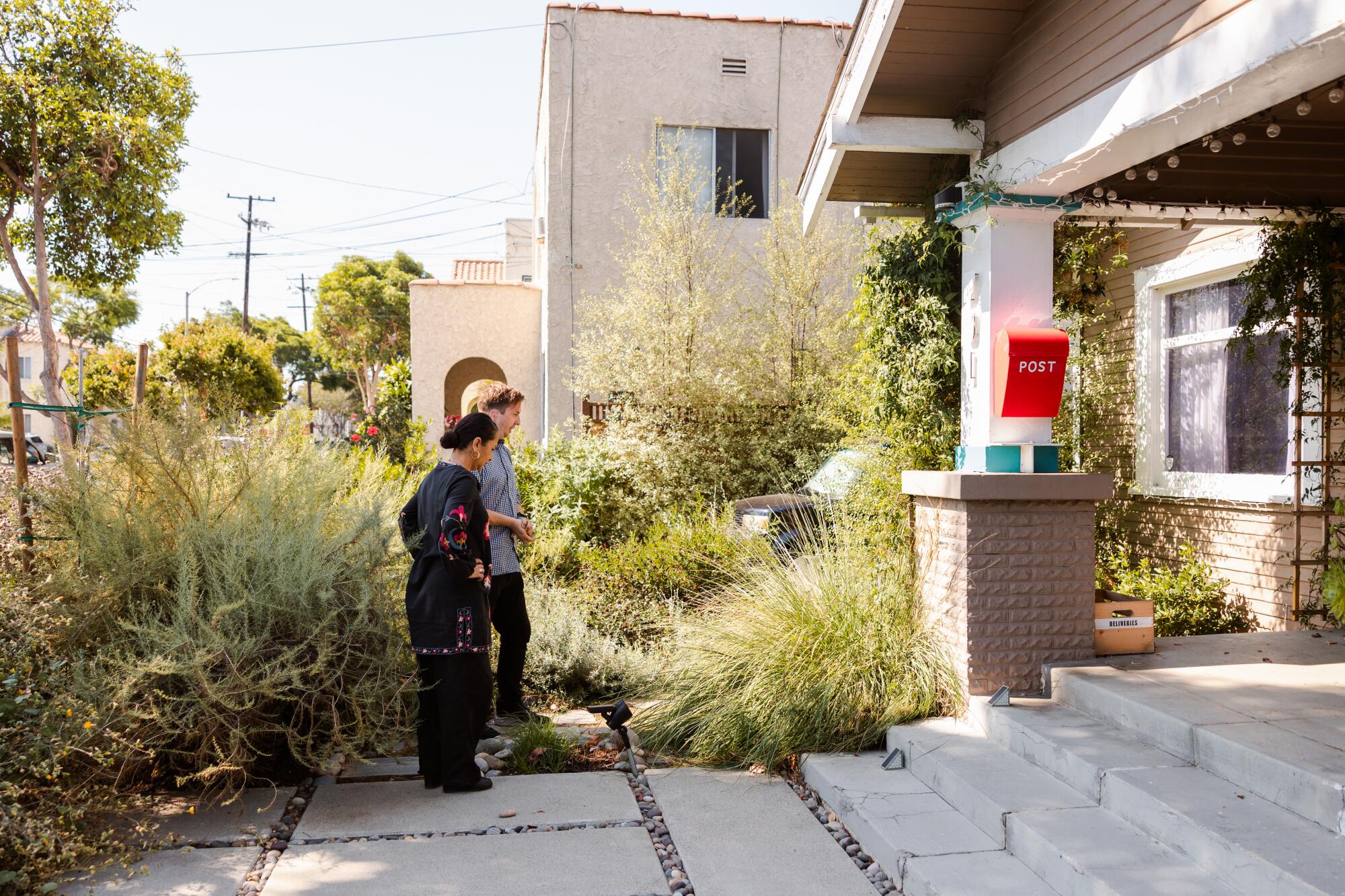
Christian Svanes Kolding and Adriana Estrada say their native landscape provides color, fragrance, water savings and a way to inspire and strike up conversations with their new neighbors. The walkway broken into sections provides space for rainwater to soak into the soil instead of running off into the street.
(Bora Chan / For The Times)
Their opportunity came in 2021, when they purchased a Craftsman-style home built in 1919 from a Pacific Ready-Cut kit in Long Beach’s Craftsman Village Historic District, a community of narrow streets, vintage homes and wide, well-used porches.
Their house is 1,050 square feet, but with the porch and their yard, it feels palatial to Estrada and Kolding, who spent 12 years living in an 850-square-foot studio apartment in New York City, “where our exterior spaces were the fire escape and front stoop,” Estrada said.
They loved the vitality of the city, but when the COVID-19 pandemic came, “we dreaded the thought of being trapped in our one-room apartment for the duration,” she said.
In the first months of the pandemic, when there was so much fear and uncertainty about how the disease was spread, Kolding said their only escape was donning bandannas and taking to the street to run.
Then Estrada’s mother called to say her father was ill. “She said, ‘You need to spend some time with your dad,’” Estrada said. “And when we got here, we realized our life living in that apartment was no longer a part of what we enjoyed.”

The bioswales in the corners of Kolding and Estrada’s frontyard are all but invisible under an aromatic jumble of silvery white sage, feathery bright green branches of sagebrush and pops of red buckwheat flowers.
(Bora Chan / For The Times)
Estrada grew up in Pico Rivera, where her mom tended roses and her dad grew lots of chile peppers in pots. Gardening held no interest for her then.
After earning a bachelor’s degree in French from Stanford and a law degree from UCLA, she worked as an attorney in San Francisco, met Kolding and realized her true passion was fashion. So the couple moved to New York, where Estrada earned a degree from the Fashion Institute of Technology. The couple then moved to Copenhagen, Kolding’s birthplace, where Estrada founded the axeSURF apparel brand before working as a designer for the now-defunct Danish company Deres, and later she designed a men’s line for Gramicci in California.
Although she loved seeing people wear her clothes, “I found the business behind fashion more interesting,” Estrada said. And she switched professions again to her present career, helping companies with branding and marketing as a partner in the Difference Engine.
Kolding, a documentary filmmaker, was born in Denmark but spent his teens in Connecticut, where his parents commuted to jobs in New York City. His mother kept a vegetable garden to supply her love of cooking.
Kolding moved to San Francisco after college in 1993. “I had the fantasy of a lot of kids, to come to California to live the dream,” he said, and helping a neighbor revive their building’s tiny garden fed into that dream, “because coming from Copenhagen, the idea of having a vegetable garden in the winter was very appealing.”

Fragrant branches of celestial blue sage climb against the couple’s waist-high fence, designed to give passersby a place to pause, admire and chat, while their dogs get a drink.
(Bora Chan / For The Times)
It also became a classic meet-cute because his gardening neighbor turned out to be Estrada’s best friend. That’s how the two met and began their journey from San Francisco to New York, Copenhagen, New York (again) and California.
When they decided to relocate in Southern California, their first step was finding the right community. They chose Long Beach because of its proximity to the beach for surfing and a preponderance of youthful — but not too youthful — vibes. As a couple in their mid-50s, they looked for areas with plenty of independent bookstores (indicators of vitality) and natural wine bars because “patrons of natural wine bars typically embody an unfussy, indie spirit, different than old-school wine bars, bars for college kids or sport bars,” Kolding explained in an email.
The home they found in Craftsman Village is just a mile from the ocean and within four blocks of Long Beach’s 4th Street “Retro Row,” which features several indie bookstores and natural wine bars.
Once they found their home, they quickly turned their attention to their yard. Their frontyard was pathetic; basically 1,500 square feet of weeds and parched patches of Bermuda lawn. And, according to Kolding, it was a popular stop for neighborhood dogs wanting to relieve themselves.
“It didn’t feel like there was a whole lot of love for any of the property,” he said.
The couple initially tried planting a few agave in the front, but Estrada was inspired by an article about ocean-friendly gardens in the Surfrider Foundation’s publication, the Drop, which featured work by Long Beach-based landscape architect Kai Craig of California Eco Design, a fellow Surfrider member.
It seemed serendipitous that he lived in Long Beach too, so Estrada and Kolding called him for help in designing their frontyard.
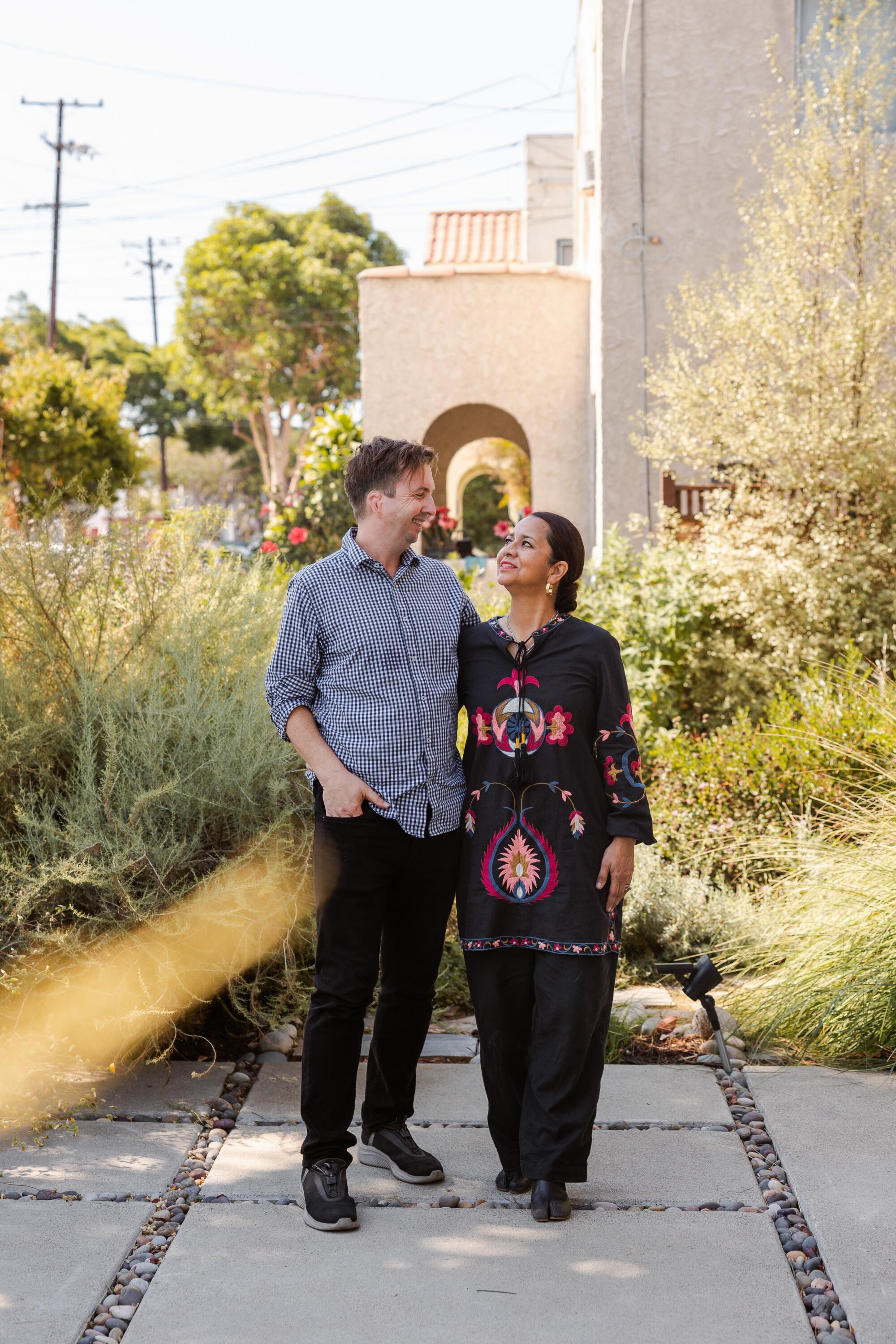
Kolding, left, and Estrada said they grew tired of the tall, forbidding fences in Venice Beach, where they lived for a while before buying their home in Long Beach. They wanted a way to frame their yard that welcomed admirers for conversation and inspiration for their own yards.
(Bora Chan / For The Times)
Initially they thought they would focus on native succulents and cactus for their yard until they began noticing white sage, buckwheats and sagebrush when they went running in the Laguna Hills and Santa Ana Mountains. “That’s when the light bulb went off for me. Why not bring some of these beautiful plants from the hills into our yard?” Kolding said.
They did the transformation in chunks. First was designing and building a handsome, waist-level fence to frame the coming landscape, all while welcoming visitors with a wide cutout at the gate. That way people could step off the sidewalk to chat or admire their changing landscape while their dogs drank from the water dish attached to a post.
The couple learned they had to maintain the historic parts of their yard with its Hollywood driveway — two strips of concrete instead of a long slab — and concrete walkway to the front porch.
In keeping with their desire for a permeable landscape, Craig recommended breaking the front walkway into large squares edged with river rocks so rainwater could flow into the ground instead of the street. The other concrete walkways were replaced by flagstones, creating more natural and permeable pathways through the garden.
On Craig’s advice, Kolding and Estrada also enrolled in Long Beach’s Lawn to Garden program, which provides a $3-per-square-foot rebate for landscapes that replace lawns with California native plants or “California-friendly” plants suitable for a Mediterranean climate. The new plantings must cover 65% of the area that was formerly covered in lawn (no synthetic turf permitted) and include efficient irrigation, a natural mulch to retain moisture and a way to capture and retain rainwater.
The rebates paid for about a third of the $17,000 project, Kolding said.
Craig satisfied the stormwater capture requirement by building two bioswales — wide shallow holes filled with smooth stones — on either side of the yard and planted thickly around them. The bioswales are designed to collect rainwater so it soaks deep in the ground.
The approach seems to be working. The plants are growing lustily in late summer, although Kolding only waters them once a week on Saturdays for a hour with drip irrigation.
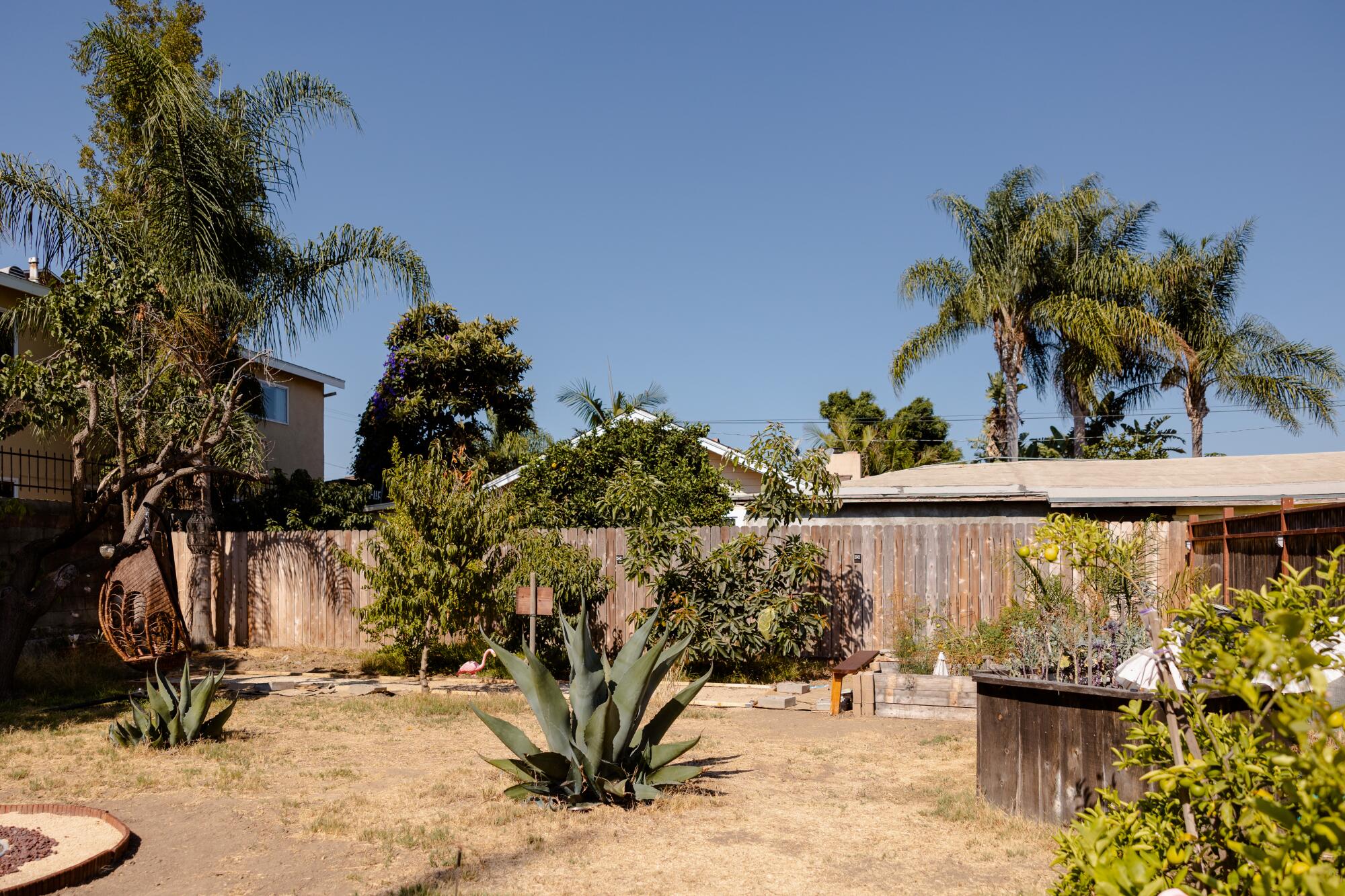
Kolding and Estrada’s next big project, after painting their home’s exterior, will be tackling their large backyard, which right now is a mix of dying, weedy grass, a few agaves transplanted from the frontyard and several fruit trees and raised beds for vegetables along the perimeter.
(Bora Chan / For The Times)
The couple also signed up for Long Beach’s Native Plant Parkway Program. While Craig’s team did most of the work creating the frontyard, Kolding and Estrada took on the job of removing the weeds and Bermuda grass in the parkway in front of their home.
In exchange, the city’s parkway program provided free native plants suitable for Long Beach to replant the area and mulch to help retain rainwater.
The work was more physically taxing than they expected, Estrada said, especially when the plants were delivered late in the day before they were supposed to leave for an extended trip. “I was out planting in the dark,” Kolding said.
But four years later, the yard and parkway are a thick tangle of grasses, green shrubs and vibrant flowers, as Kolding makes clear in an endearing short documentary film about their new landscape.
The bioswales are effective at stopping runoff and pooling water — Kolding said the yard used to have an unsightly pool of standing water after a heavy rain — but they’re almost invisible under the (mostly) native grasses and shrubs in almost every shade of green, from the fragrant silvery greens of California sagebrush and white sage to deep green bunches of European grey sedge.
Tall pale-green stands of deergrass grow like sentries on either side of the porch, which is laced with non-native pink jasmine, one of the first plants they added before they settled on their palette of native plants.
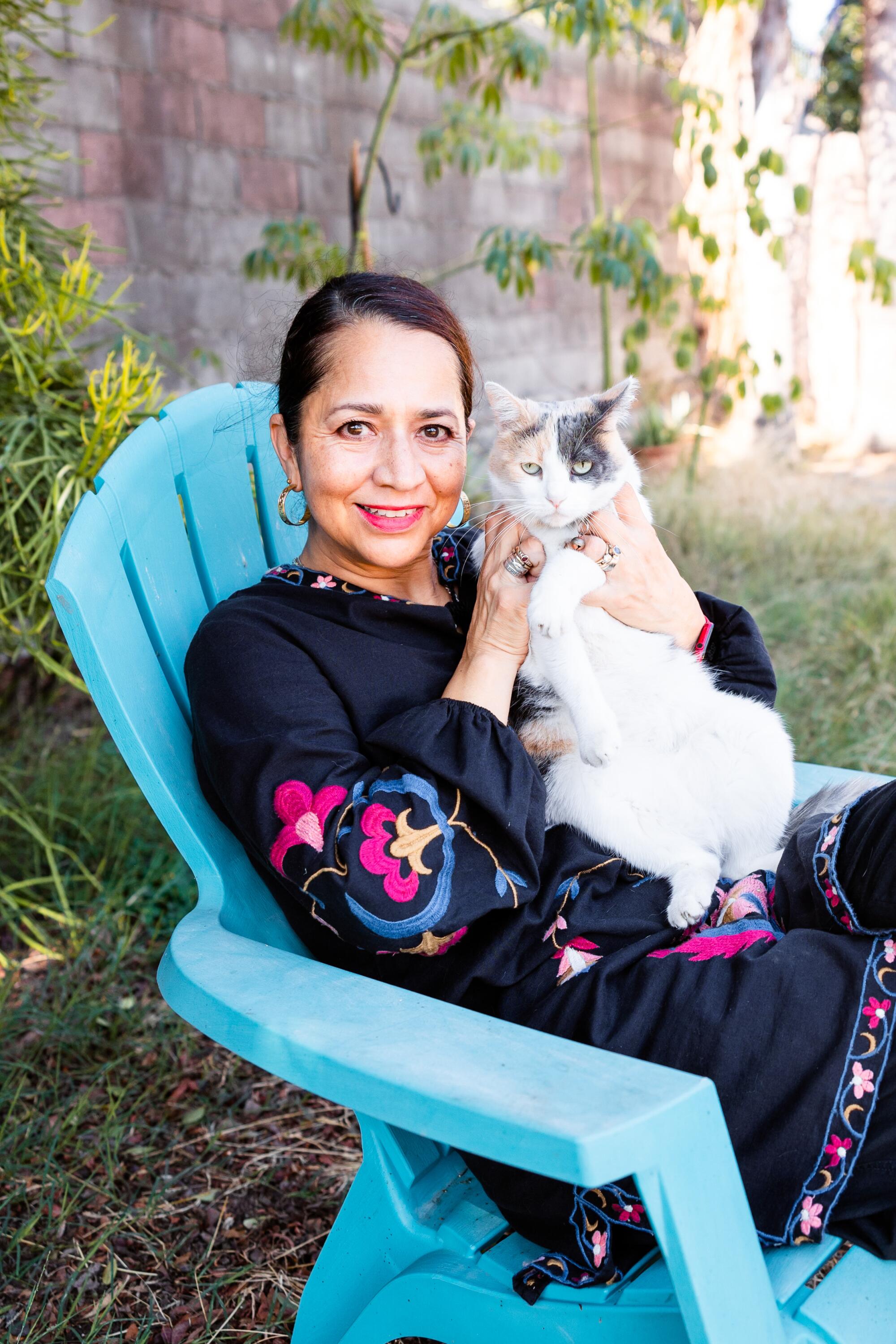
Adriana Estrada agreed to foster a feral cat who needed a place to recover after surgery. The couple’s slightly aloof, very lovable white calico cat named Margot Tenenbaum went from being feral to a beloved princess in their home.
(Bora Chan / For The Times)
Now the couple’s broad porch is their morning retreat. It’s where Kolding goes every morning to write, after he fills the little water dish for passing dogs outside their gate.
In the early morning, the east-facing yard is alive with butterflies and bees, dancing over electric-purple whorls of celestial blue sage and sunny Palmer’s Indian mallow growing over the fence. Bright green coyote mint adds more fragrance and color with its violet puffs of flowers.
Gray-green Hollywood Flame fuchsia are just starting to bloom in long red tubes and are irresistible to hummingbirds. Also, monarch butterflies flit among the tall stands of narrow leaf milkweed, the plant their caterpillars require to survive.
Not all the plants are California natives. On the south side of the porch and along their driveway, a few tall, airy Silver Sheen Kohuhu (Pittosporum tenuifolium ‘Silver Sheen’) provide privacy and beauty, with dark reddish stems and small pale-green leaves.
A blooming pink jasmine frames the porch, and a quick-growing Sierra fig tree they got from the city for free will soon provide shade and fruit at the northeast edge of the frontyard. (Kolding uses the fig’s broad leaves to wrap around white fish rubbed with olive oil, salt and pepper. He said the leaves keep the fish moist while he bakes them for a few minutes in a hot oven and add a slightly nutty flavor.)
Estrada and Kolding plan to paint their home next, and then they look forward to tackling their large backyard, which will be a much bigger and more expensive project.
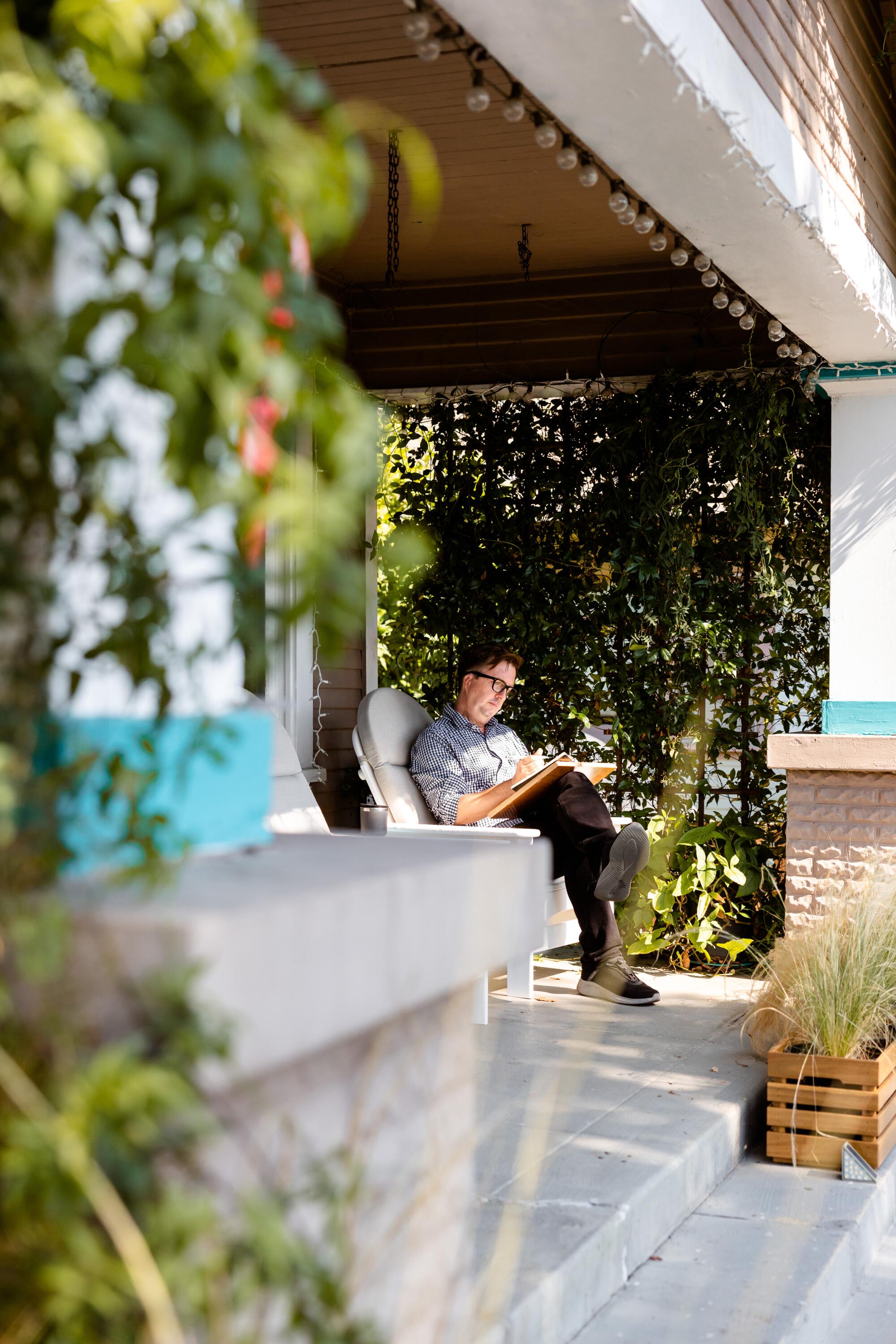
Kolding says he spends at least 30 minutes every morning writing on his leafy front porch.
(Bora Chan / For The Times)
Estrada is impatient to move ahead but also appreciates that she and her husband need the time to better understand their yard and how it can be used. She advises breaking such yard projects into chunks to make them more affordable and easier to plan. Taking that time has helped them realize they want to retain their raised garden beds and fruit trees in the backyard, including vigorous avocado and pomegranate trees grown from seeds.
And they want to add some walkways and more fragrant plantings as well as a large space to enjoy the shade in the afternoon.
They also want the design to allow for the little “skunk-raccoon-possum highway” in their backyard, Estrada said. They are one of the few neighborhood homes without a dog in their backyard, so those nocturnal animals travel along their fence line in relative safety, “and they do us the favor of eating all the grubs in our raised beds,” Kolding said. (The couple’s formerly feral calico cat, Margot Tenenbaum, whose name is inspired by the character in the 2001 film “The Royal Tenenbaums,” seems indifferent to hunting anything but lizards.)
For now, Estrada and Kolding are basking in their perfumed frontyard. Just off the porch, fluttering in the breeze, is a large blue-and-white “Casa Hiatus” flag, which Kolding and Estrada designed to represent their vision of this yard as a place to pause and reflect. It’s an idea even built into the fence design, where passersby often step off the public sidewalk out of the “flow,” to chat or just savor the yard’s many colors and scents.
The term “represents what we want our home to be,” Kolding said, “a space that invites people to step into both the garden and the house.”
Plants (Native)
Berkeley sedge, a.k.a. foothill sedge (Carex tumulicola)
Bush monkey flower (Diplacus aurantiacus)
California lilac (Ceanothus thyrsiflorus ‘Skylark’)
California sagebrush (Artemisia californica)
Celestial blue sage (Salvia ‘Celestial Blue’)
Chaparral beardtongue (Keckiella antirrhinoides var. antirrhinoides)
Coffeeberry (Frangula californica)
Coyote mint (Monardella villosa)
Deergrass (Muhlenbergia rigens)
Giant wildrye (Elymus condensatus)
Hollywood Flame Hummingbird Fuchsia (Epilobium canum ‘Hollywood Flame’)
Hummingbird sage (Salvia spathacea)
Louis Edmunds baker’s manzanita (Arctostaphylos bakeri ‘Louis Edmunds’)
Mountain mahogany (Cercocarpus betuloides)
Narrowleaf milkweed (Asclepias fascicularis)
Palmer’s Indian mallow (Abutilon palmeri)
Pink-flowering currant (Ribes sanguineum var. glutinosum)
Point St. George aster (Symphyotrichum chilense ‘Point Saint George’)
Red-flowered buckwheat (Eriogonum grande var. rubescens)
white sage (Salvia apiana)
Yarrow (various) (Achillea millefolium)
Plants (Non-native)
Coral bells (Heuchera ‘Siren’s Song’)
European grey sedge (Carex divulsa)
Pink Jasmine (Jasminum polyanthum)
Sierra fig
Silver Sheen Kohuhu (Pittosporum tenuifolium ‘Silver Sheen’)
Resources
Long Beach’s Lawn to Garden program
Long Beach’s Native Plant Parkway Program
Long Beach’s Tree Planting Program



